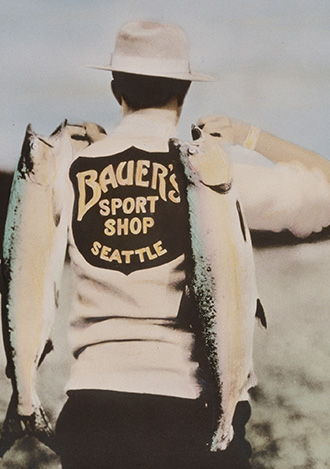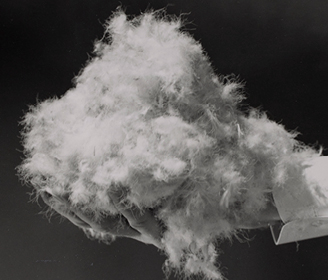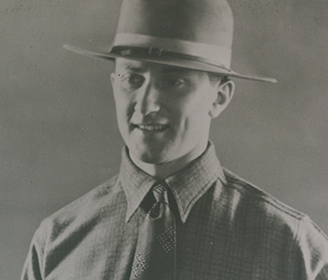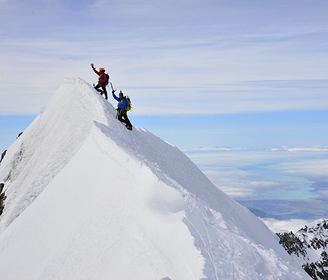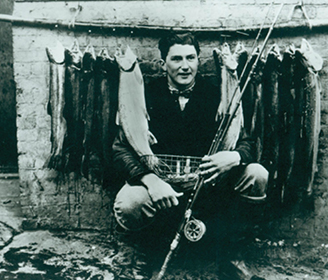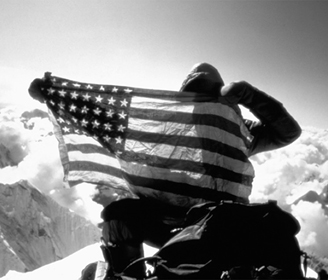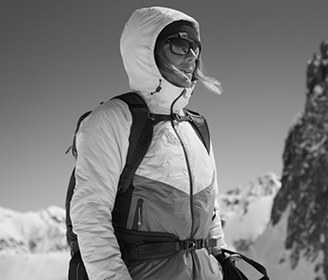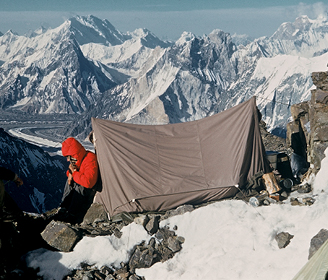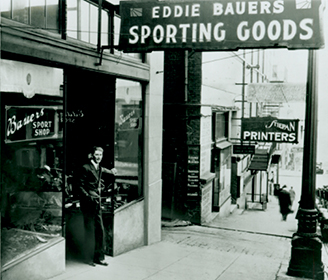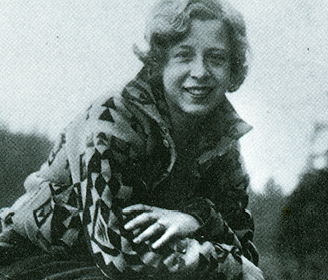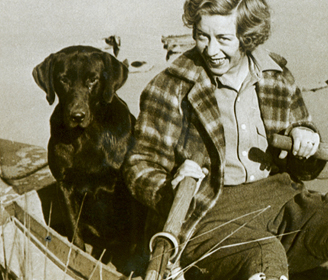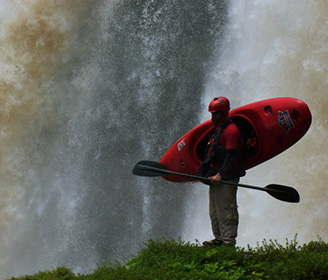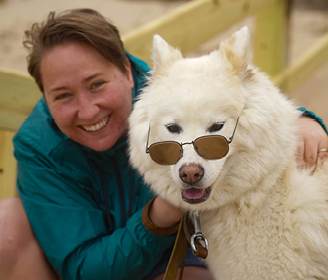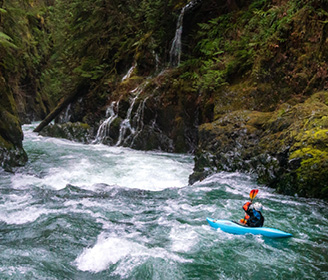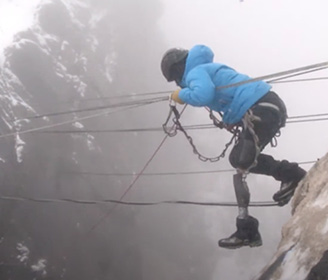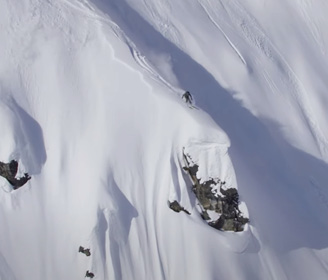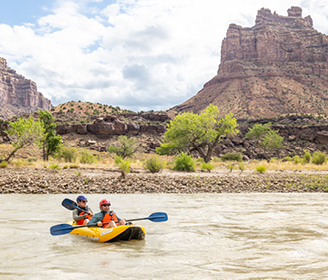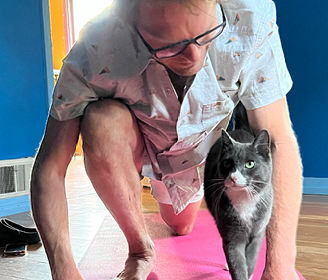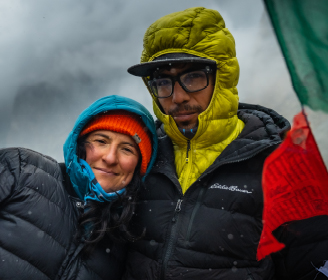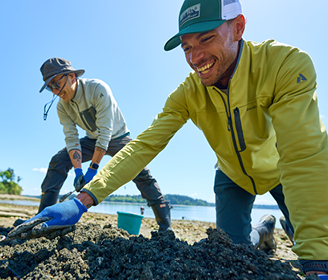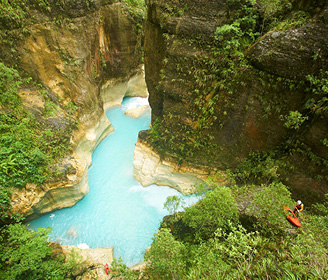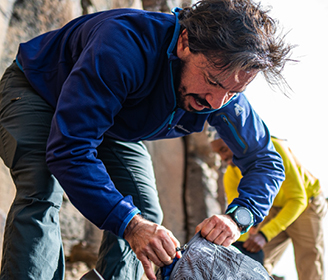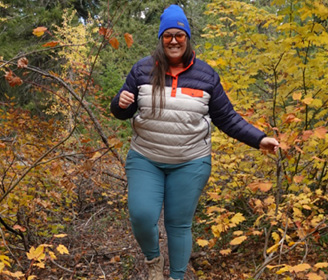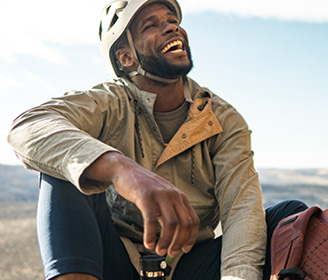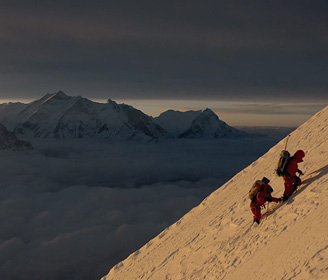In what would turn out to be a tone-setting moment for the future couple, Stine Heltborg met Eddie Bauer on a hunting trip and immediately began changing his perspective.
Days earlier, in the fall of 1927, Stine had been invited to join a group of friends to hunt blue grouse on Bodie Mountain in northeastern Washington. She didn’t hunt at the time but was looking forward to helping at camp and escaping the city for a couple of weeks.
As they neared the mountain, Stine asked the leader of the group, Walt Milo, how he had found the abandoned homestead where they would be camping. Walt told her that a friend of his who hunted a lot had shown him the spot a couple of years ago. What Walt did not share with Stine was that his hunting friend had also sworn him to secrecy about the location.
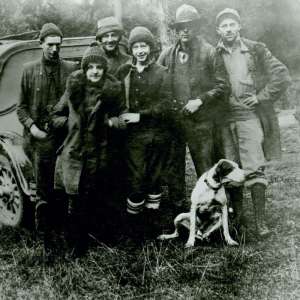
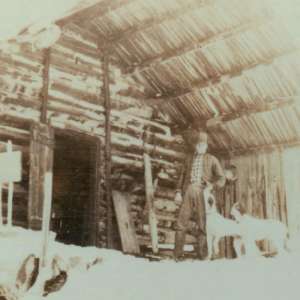
Left: Bodie Mountain, 1927: L/R: Harry Cowan, Bess Hansen, Walter Hansen, Christine Heltborg, John Jilg, Silver, Water Milo. |
Right: Bodie Mountain, 1927: John Jilg with Silver and Red at the abandoned Rusk cabin.
Two days later, as the group was sitting down to dinner, they saw headlights coming up the narrow road. Walt knew who must be driving the car.
Before his friend could lodge a complaint, Walt set about introducing his group, ending with Stine and hoping that her smile would diffuse some of his friend’s obvious displeasure.
“I’m Eddie Bauer,” Walt’s friend said, offering Stine his hand.
“Why don’t you join us for dinner?” Stine invited.
Two days later Eddie cut short his own trip to accompany the group back to Seattle. He had Stine’s number in his pocket, but it wasn’t until the following spring that he would use it.
When Eddie finally gave Stine a call, it was to invite her on a fishing trip to the notoriously cold and wet Olympic Peninsula. It rained and snowed the whole April day, but far from complaining, Stine enjoyed herself.
Eddie was hooked.
The two became engaged during a fall deer hunting trip to their friends’ British Columbia ranch and were married on February 19, 1929. Throughout their life together, Eddie called Stine his “Wilderness Companion.”
EARLY LIFE
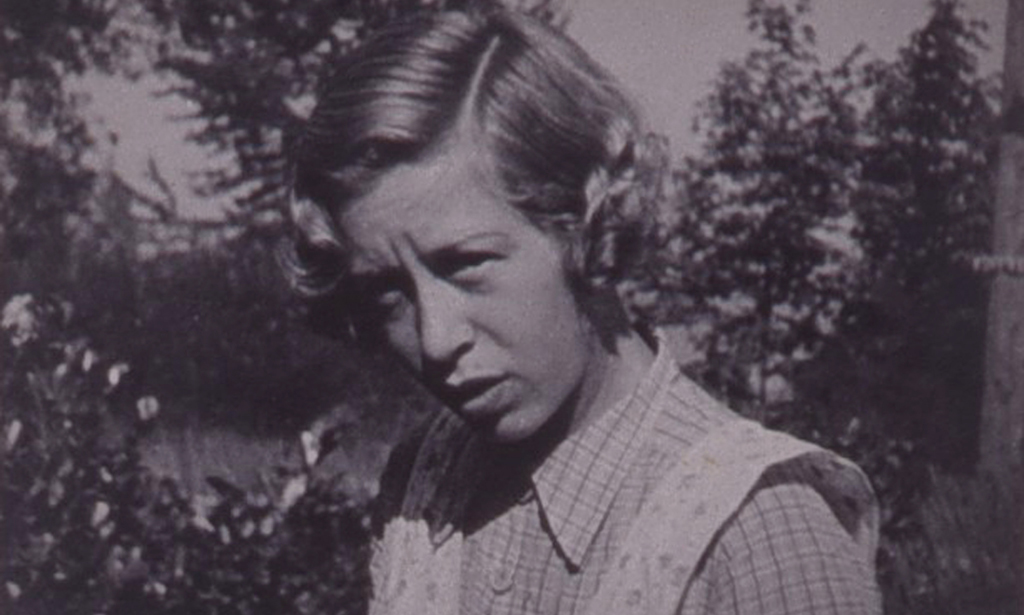
Before she became Mrs. Bauer, Stine was Christine Heltborg. She was born on August 3, 1903, the third of her Danish immigrant parents’ four children. The Danish pronunciation of her name was “Cris-TEE-neh,” and her nickname was “STEE-neh.” However, it was spelled “S-t-i-n-e,” and this became “STY-n” in English.
Her carpenter father died during the 1918 Spanish flu pandemic, and as the strongest of the children, Stine left school at 15 to support the family as a coat finisher in a tailor shop.
By her early twenties, Stine had left her work as a finisher and bought a beauty parlor that she kept into the late 1920s. Eventually, she decided that she wanted to be free of the set hours and responsibility of running the shop, so she sold the business and went back to work as a finisher. It was around this time that she met Eddie on Bodie Mountain and the trajectory of both of their lives changed.
THE WOMEN’S DEPARTMENT
Stine was not only Eddie’s “Wilderness Companion,” but soon after they were married, she also became an essential part of the Eddie Bauer business, bringing new attention and new ideas to the operation. And no one could question her outdoor acumen.
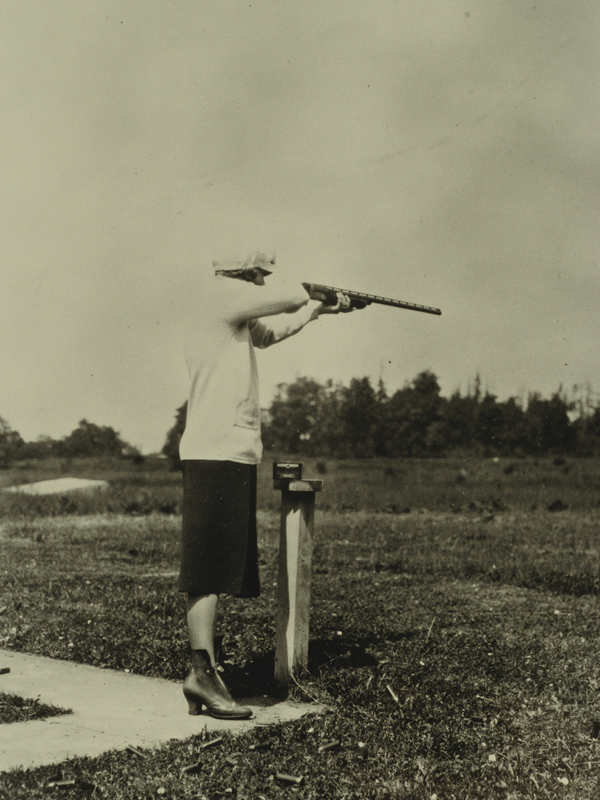
Shortly after they were married, Stine asked Eddie to teach her to shoot, and it only took a couple of days of trap shooting at the Seattle Gun Club before Stine was matching Eddie shot-for-shot. For eight years, from 1930 to 1938, Stine competed in the Washington State Trap Shooting Championship. She won the women’s trophy every time.
Photo: Seattle Gun Club, ca 1930: Stine refining her championship form.
At a 1932 trap shooting competition put on by The Seattle Daily Times, Stine found herself shooting alongside Olympic trap shooting gold medalist Frank Troeh, who was widely considered the finest trapshooter in the world. At the end of four rounds, Stine and Frank were even, each with 99 of 100 birds broken, and the crowd went wild.
In addition to her success as a hunter, Stine garnered attention with her skills on the water. Only two months after her first date with Eddie, Stine was photographed alongside the Sport Shop’s resident master fisherman in an article about sport salmon fishing. Later that year, she was part of a four-person guide team that a Hollywood film crew hired when they came north to produce a newsreel about salmon spinning.
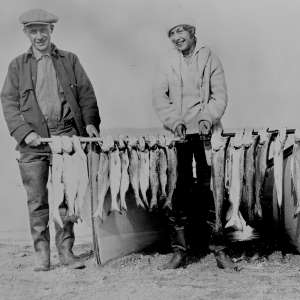
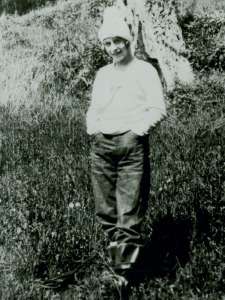
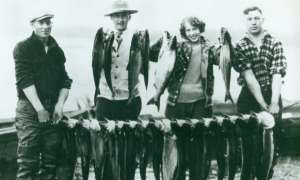
Clockwise: June 17, 1928: Bill Lindberg and Stine Heltborg display a catch for a full-page article in The Seattle Daily Times about salmon spinning. | Baby Island, 1928: Stine on a fishing date with Eddie and lifelong friends John and Blanch Jilg. | Steamboat Island, 1928: Emil Johnson, Eddie, Stine, and Gatch Coho pose for the Hollywood film crew producing a newsreel on salmon spinning.
Stine’s much-lauded outdoor prowess brought free, powerful marketing to Eddie Bauer’s Sport Shop. Her exploits often landed her in the paper—including a front-page story in The Seattle Daily Times, for which she was photographed on skis, chopping down a Christmas tree—and every time they did, the business broadened its appeal.
Her daily presence in the shop also showed her value. Stine was by no means the first woman to set foot inside the Sport Shop, nor was she Eddie Bauer’s first female employee. That honor belonged to Isabel McDonald, an expert fly tier who began selling her flies at the newly established Eddie Bauer Tackle Makers in 1924.
When Stine arrived in 1929, she rapidly reframed what an outdoor enthusiast looked like. Eddie liked to brag of her ability to hunt, field dress, and skin large game like deer and elk. “She had more stamina than I did in the backcountry,” he was fond of saying.
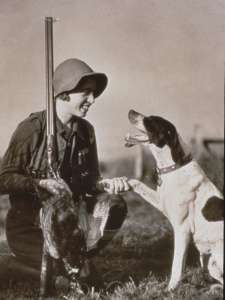
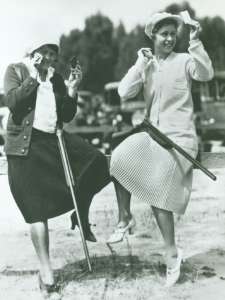
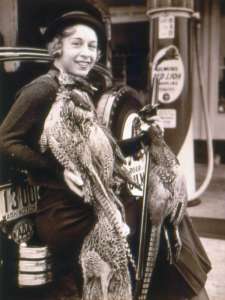
Left: Stine and Belle, ca 1929: Mrs. Bauer was a favorite of news photographers.
Center: Seattle Gun Club, ca 1930: Stine (right) and friend vamp for the camera as they wait to compete at a shoot.
Right: Trophy Shot, ca 1930: Stine gives the Sport Shop a fresh face.
Having hunted and fished alongside the shop’s rugged outdoorsmen regulars, she could talk shop with the best of them, but she did it while wearing high-heeled pumps and decidedly un-rugged dresses.
Stine also saw an entire market of avid outdoorswomen whose needs were not being served by outfitters, and she set about correcting that error. Early in her tenure, Stine began adding women’s sports apparel to the store’s offerings.
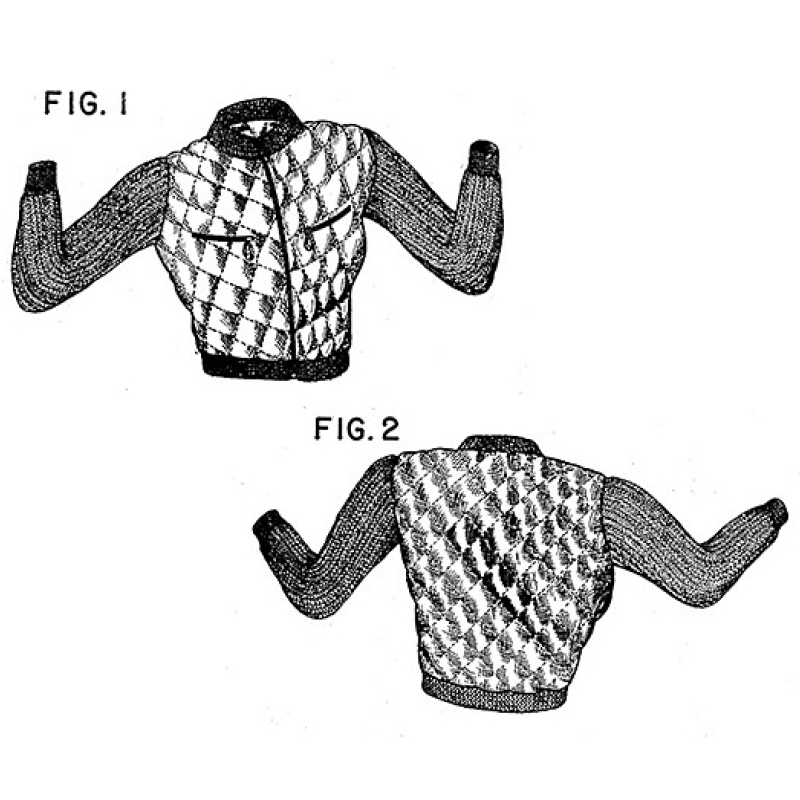
Later, when Eddie started developing his groundbreaking down outerwear—including the Skyliner jacket—Stine insisted he include women’s versions, and in the 1940s, the company introduced two women’s-only down jackets: the Olympic Model and the Swiss Model Ski Jackets.
This early adoption of women’s technical outerwear would not have happened without Stine’s outspoken advocacy.
LIFE AFTER THE STORE
In 1944, toward the end of World War II, fearing the possibility of air raids, Stine insisted that the family move to their 50-acre farm in Redmond, 10 miles east of Seattle. Stine stopped working in the store during the 9 years that she, Eddie, and their young son, Eddie Christian, stayed on the east side of Lake Washington.
Instead, she ran the farm, taking care of everything from tending their subsistence garden to raising, managing, and slaughtering their livestock. Her strength and adaptability were particularly critical when Eddie’s health broke down after the war and he was unable to work for two years.
In 1953, they moved to downtown Bellevue. Without the farm or the store, Stine found herself burdened with a substantial amount of idle time, so she enrolled in art classes and took up painting.
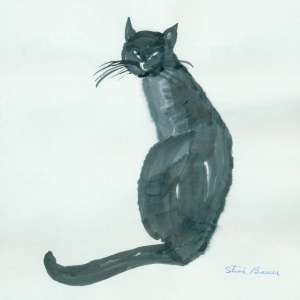
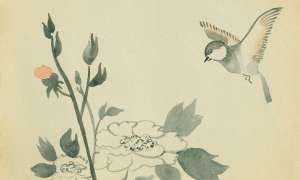
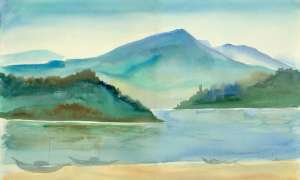
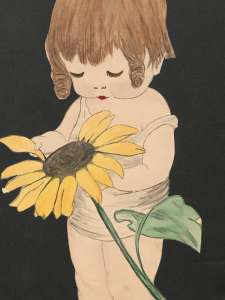
Artwork from Stine, ca 1960s: Nature is a central recurring theme in Stine’s art, evoking the landscapes she and Eddie traversed together for many years.
In February of 1986, within days of their 57th wedding anniversary, Stine was diagnosed with pancreatic cancer. Less than two months later, on April 3, Eddie Bauer lost his wilderness companion. Though in good health at the time, Eddie quickly faded and died fifteen days after Stine’s passing.
Stine’s enchanting combination of gracious refinement in town and complete ease in the backcountry, along with her exceptional talents ranging from champion markswoman and professional seamstress to amateur artist and avid traveler, made her not only the perfect role model for a fledgling outdoor brand, but also the best partner Eddie could have asked for.
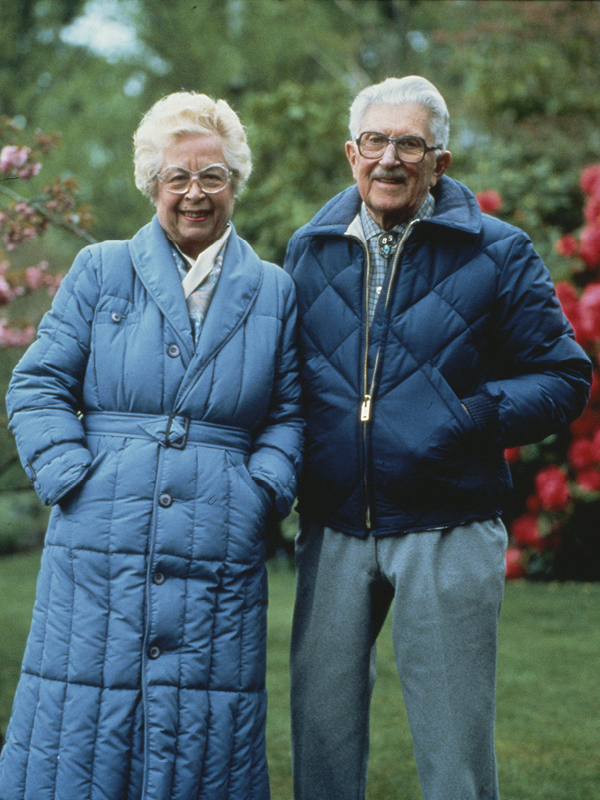
Photo: Eddie and Stine, ca 1983: At their home in Bellevue, Eddie and Stine model two of the signature down products that made the Bauer name famous.
Visit the Eddie Bauer Historical Archive
Learn more about the history of Eddie Bauer and read more stories like the one above.

